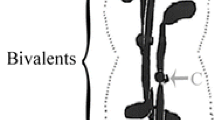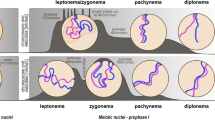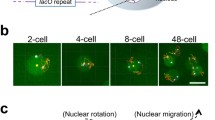Abstract
The positions of the two sets of chromosome kinetochores, the spindle poles, cell membrane adjacent to the poles, and cleavage furrow of grasshopper neuroblasts in culture at 38°C were determined at short-time intervals during anaphase. The percent of motion due to poleward movement and spindle elongation, which coincide in time, were calculated for each minute, the former falling from 61% in the first minute to 15% in the seventh minute, and increasing to 86% in the final minute, probably as a result of pressure and bending of the spindle. Of the total chromosome movement during anaphase 44.6% is due to poleward movement of the daughter kinetochores and 55.4% to spindle elongation. The maximum velocity of a set of kinetochores is 3.41 μm/min and the mean velocity 1.86 μm/min (one-half the rate of separation). Various studies of anaphase chromosome movement in different cells and different species suggest certain generalizations, some of which are based on very small samples and so must be considered quite tentative: (1) The combination of poleward movement and spindle elongation is much more frequent than either acting alone. (2) These components of movement may coincide in time, overlap, or spindle elongation may follow poleward movement, but spindle elongation never begins before poleward chromosome movement. (3) There is an optimum temperature for the rate of chromosome movement, above and below which the rate gradually decreases. (4) In homoiothermic animals this optimum occurs at normal body temperature. (5) In homoiothermic animals the velocity falls more rapidly with a decrease in temperature than in poikilothermic animals. (6) Animals with large chromosomes (amphibia, grasshoppers) have higher chromosome velocities than those with small chromosomes. (7) Non-meiotic cells and secondary spermatocytes have higher velocities than primary spermatocytes of the same species. (8) Chromosome velocity is lower in malignant than non-malignant cells. (9) Chromosome velocity tends to be positively correlated with the distance the chromosomes travel during anaphase.
Similar content being viewed by others
References
Bajer, A.: Electrical forces in mitosis. I. Acta Soc. Bot. Poloniae 20, 709–737 (1950)
Bajer, A., Molè-Bajer, J.: Influence of extreme temperatures on mitosis in vivo. I. Hymenophyllum. Acta Soc. Bot. Polaniae 22, 267–298 (1953)
Bajer, A., Molè-Bajer, J.: Endosperm, material for study on the physiology of cell division. Acta Soc. Bot. Poloniae 23, 69–110 (1954)
Barber, H.N.: The rate of movement of chromosomes on the spindle. Chromosoma (Berl.) 1, 33–50 (1939)
Bělař, K.: Beiträge zur Kausalanalyse der Mitose. III. Untersuchungen an den Staubfadenhaarzellen und Blattmeristemzellen von Tradescantia virginica. Z. Zellforsch. 10, 73–134 (1929)
Boss, J.: Mitosis in cultures of new tissues. III. Cleavage and chromosome movements in anaphase. Exp. Cell Res. 7, 443–456 (1954)
Bucciante, L.: Ulteriori richerce sulla velocita della mitosa nelle cellule Cultivate “in vitro” in funzione della temperatura. Arch. exp. Zellforsch. 5, 1–24 (1927)
Campbell, F.L. (ed.): Physiology of insect development. Chicago: The University of Chicago Press 1959
Carlson, J.G.: Microdissection studies of the dividing neuroblast of the grasshopper, Chortophaga viridifasciata (DeGeer). Chromosoma (Berl.) 5, 199–220 (1952)
Carlson, J.G.: On the mitotic movements of chromosomes. Science 124, 203–206 (1956)
Carlson, J.G.: The grasshopper neuroblast culture technique and its value in radiobiological studies. Ann. N.Y. Acad. Sci. 95, 932–941 (1961)
Carlson, J.G.: Mitotic effects of monochromatic ultraviolet radiation at 225, 265, and 280 nm on eleven stages of the cell cycle of the grasshopper neuroblast in culture. 1. Overall retardation from the stage irradiated to nuclear membrane breakdown. Radiation Res. 68, 57–74 (1976)
Carlson, J.G., Gaulden, M.E.: Grasshopper neuroblast techniques. In: Methods in cell physiology (D.M. Prescott, ed.), pp. 229–276. New York: Academic Press 1964
Carlson, J.G., Hollaender, A.: Mitotic effects of ultraviolet radiation of the 2250 Å region with special reference to the spindle and cleavage. J. cell. comp. Physiol. 31, 149–173 (1948)
Comandon, J., Jolly, J.: Étude cinématographique de la division cellulaire. J. Physiol. Path. gén. 17, 573–589 (1917)
Dietz, R.: Die Assembly-Hypothese der Chromosomenbewegung und die Veränderungen der Spindellänge während der Anaphase I in Spermatocyten von Pales ferruginea (Tipulidae, Diptera). Chromosoma (Berl.) 38, 11–76 (1972)
Fell, H.B., Hughes, A.F.: Mitosis in the mouse: a study of living and fixed cells in tissue cultures. Quart. J. micr. Sci. 90, 355–380 (1949)
Forer, A., Koch, C.: Influence of autosome movements and of sex-chromosome movements on sex-chromosome segregation in crane fly spermatocytes. Chromosoma (Berl.) 40, 417–442 (1973)
Gaulden, M.E., Carlson, J.G.: Action of different concentrations of colchicine on spindle formation and chromosome arrangement as revealed in the living cell. Exp. Cell Res. 2, 416–433 (1951)
Hsu, T.C.: Mammalian chromosomes in vitro. VI. Observations on mitosis with phase cinematography. J. nat. Cancer Inst. 16, 691–703 (1955)
Hughes, A.F.W., Preston, M.M'E.: Mitosis in living cells of amphibian tissue cultures. J. roy micr. Soc., Ser. III, 69, 121–131 (1949)
Hughes, A.F., Swann, M.M.: Anaphase movements in the living cell. A study with phase contrast and polarized light on chick tissue cultures. J. exp. Biol. 25, 45–70 (1948)
Izutsu, K.: Phase-contrast cinematographic studies on meiosis in orthopteran spermatocytes. II. Chromosome movement in the first meiotic anaphase. Cytologia (Tokyo) 25, 293–304 (1960)
Jacquez, J.A., Biesele, J.J.: A study of Michel's film on meiosis in Psophus stridulus L. Exp. Cell Res. 6, 17–29 (1954)
Jolly, J.: Recherches expérimentales sur la division indirecte des globules rouges. Arch. d'Anat. microsc. 6, 455–632 (1904)
Kawamura, K.: Studies on cytokinesis in neuroblasts of the grasshopper, Chortophaga viridifasciata (DeGeer). I. Formation and behavior of the mitotic apparatus. Exp. Cell Res. 21, 1–8 (1960a)
Kawamura, K.: Studies on cytokinesis in neuroblasts of the grasshopper, Chortophage viridifasciata (DeGeer). II. The role of the mitotic apparatus in cytokinesis. Exp. Cell Res. 21, 9–18 (1960b)
Kawamura, K.: Microdissection studies on the dividing neuroblast of the grasshopper, with special reference to the mechanism of unequal cytokinesis. Exp. Cell Res. 106, 127–137 (1977)
Kawamura, K., Carlson, J.G.: Studies on cytokinesis in neuroblasts of the grasshopper, Chortophaga viridifasciata (DeGeer). III. Factors determining the location of the cleavage furrow. Exp. Cell Res. 26, 411–423 (1962)
Makino, S., Nakanishi, Y.H.: A quantitative study on anaphase movement of chromosomes in living grasshopper spermatocytes. Chromosoma (Berl.) 7, 439–450 (1955)
Nicklas, R.B.: Chromosome velocity during mitosis as a function of chromosome size and position. J. Cell Biol. 25, 119–135 (1965)
Ris, H.: A quantitative study of anaphase movement in the aphid Tamalia. Biol. Bull. 85, 164–178 (1943)
Ris, H.: The anaphase movement of chromosomes in the spermatocytes of the grasshopper. Biol. Bull. 96, 90–106 (1949)
Roberts, H.S.: The mechanism of cytokinesis in neuroblasts of Chortophaga viridifasciata (DeGeer). J. exp. Zool. 130, 83–105 (1955)
Wheeler, W.M.: A contribution to insect embryology. J. Morph. 8, 1–160 (1893)
Zirkle, R.E.: Ultraviolet-microbeam irradiation of newt-cell cytoplasm: spindle destruction, false anaphase, and delay of true anaphase. Radiation Res. 41, 516–537 (1970)
Author information
Authors and Affiliations
Rights and permissions
About this article
Cite this article
Carlson, J.G. Anaphase chromosome movement in the unequally dividing grasshopper neuroblast and its relation to anaphases of other cells. Chromosoma 64, 191–206 (1977). https://doi.org/10.1007/BF00328077
Received:
Accepted:
Issue Date:
DOI: https://doi.org/10.1007/BF00328077




